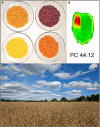Born of frustration: the emergence of Camelina sativa as a platform for lipid biotechnology
- PMID: 39813144
- PMCID: PMC11812462
- DOI: 10.1093/plphys/kiaf009
Born of frustration: the emergence of Camelina sativa as a platform for lipid biotechnology
Abstract
The emerging crop Camelina sativa (L.) Crantz (camelina) is a Brassicaceae oilseed with a rapidly growing reputation for the deployment of advanced lipid biotechnology and metabolic engineering. Camelina is recognized by agronomists for its traits, including yield, oil/protein content, drought tolerance, limited input requirements, plasticity, and resilience. Its utility as a platform for metabolic engineering was then quickly recognized, and biotechnologists have benefited from its short life cycle and facile genetic transformation, producing numerous transgenic interventions to modify seed lipid content and generate novel products. The desire to work with a plant that is both a model and crop has driven the expansion of research resources for camelina, including increased availability of genome and other -omics data sets. Collectively, the expansion of these resources has established camelina as an ideal plant to study the regulation of lipid metabolism and genetic improvement. Furthermore, the unique characteristics of camelina enables the design-build-test-learn cycle to be transitioned from the controlled environment to the field. Complex metabolic engineering to synthesize and accumulate high levels of novel fatty acids and modified oils in seeds can be deployed, tested, and undergo rounds of iteration in agronomically relevant environments. Engineered camelina oils are now increasingly being developed and used to sustainably supply improved nutrition, feed, biofuels, and fossil fuel replacements for high-value chemical products. In this review, we provide a summary of seed fatty acid synthesis and oil assembly in camelina, highlighting how discovery research in camelina supports the advance of metabolic engineering toward the predictive manipulation of metabolism to produce desirable bio-based products. Further examples of innovation in camelina seed lipid engineering and crop improvement are then provided, describing how technologies (e.g. genetic modification [GM], gene editing [GE], RNAi, alongside GM and GE stacking) can be applied to produce new products and denude undesirable traits. Focusing on the production of long chain polyunsaturated omega-3 fatty acids in camelina, we describe how lipid biotechnology can transition from discovery to a commercial prototype. The prospects to produce structured triacylglycerol with fatty acids in specified stereospecific positions are also discussed, alongside the future outlook for the agronomic uptake of camelina lipid biotechnology.
© The Author(s) 2025. Published by Oxford University Press on behalf of American Society of Plant Biologists.
Conflict of interest statement
Conflict of interest. The authors declare no conflicts.
Figures


Similar articles
-
Camelina sativa: An ideal platform for the metabolic engineering and field production of industrial lipids.Biochimie. 2016 Jan;120:9-16. doi: 10.1016/j.biochi.2015.06.009. Epub 2015 Jun 21. Biochimie. 2016. PMID: 26107412 Review.
-
Metabolic Engineering a Model Oilseed Camelina sativa for the Sustainable Production of High-Value Designed Oils.Front Plant Sci. 2020 Feb 12;11:11. doi: 10.3389/fpls.2020.00011. eCollection 2020. Front Plant Sci. 2020. PMID: 32117362 Free PMC article. Review.
-
Synthetic redesign of plant lipid metabolism.Plant J. 2016 Jul;87(1):76-86. doi: 10.1111/tpj.13172. Epub 2016 Jun 20. Plant J. 2016. PMID: 27483205 Free PMC article. Review.
-
Interactions between genetics and environment shape Camelina seed oil composition.BMC Plant Biol. 2020 Sep 14;20(1):423. doi: 10.1186/s12870-020-02641-8. BMC Plant Biol. 2020. PMID: 32928104 Free PMC article.
-
Engineering Camelina sativa (L.) Crantz for enhanced oil and seed yields by combining diacylglycerol acyltransferase1 and glycerol-3-phosphate dehydrogenase expression.Plant Biotechnol J. 2018 May;16(5):1034-1045. doi: 10.1111/pbi.12847. Epub 2017 Nov 19. Plant Biotechnol J. 2018. PMID: 28975735 Free PMC article.
References
-
- Abdullah HM, Pang N, Chilcoat B, Shachar-Hill Y, Schnell D, Dhankher OP. Overexpression of the phosphatidylcholine: diacylglycerol cholinephosphotransferase (PDCT) gene increases carbon flux toward triacylglycerol (TAG) synthesis in Camelina sativa seeds. Plant Physiol Biochem. 2024:208:108470. 10.1016/j.plaphy.2024.108470 - DOI - PubMed
-
- Alkotami L, White DJ, Schuler KM, Esfahanian M, Jarvis BA, Paulson AE, Koley S, Kang J, Lu C, Allen DK, et al. Targeted engineering of camelina and pennycress seeds for ultrahigh accumulation of acetyl-TAG. Proc Natl Acad Sci U S A. 2024:121(47):e2412542121. 10.1073/pnas.2412542121 - DOI - PMC - PubMed
-
- An D, Suh M. Overexpression of Arabidopsis WRI1 enhanced seed mass and storage oil content in Camelina sativa. Plant Biotechnol Rep. 2015:9(3):137–148. 10.1007/s11816-015-0351-x - DOI
-
- Andre C, Buesen R, Riffle B, Wandelt C, Sottosanto JB, Marxfeld H, Strauss V, van Ravenzwaay B, Lipscomb EA. Safety assessment of EPA + DHA canola oil by fatty acid profile comparison to various edible oils and fat-containing foods and a 28-day repeated dose toxicity study in rats. Food Chem Toxicol. 2019:124:168–181. 10.1016/j.fct.2018.11.042 - DOI - PubMed
Publication types
MeSH terms
Substances
Grants and funding
LinkOut - more resources
Full Text Sources

